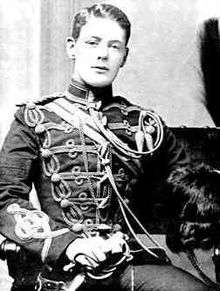Cornet (rank)

Cornet was originally the third and lowest grade of commissioned officer in a British cavalry troop, after captain and lieutenant.
It was abolished in the Cardwell Reforms of 1871, except in the Blues and Royals[1] and Queen's Royal Hussars, where it is still used. It is equivalent to today's second lieutenant.
This rank was also used in other countries, e.g., in the Russian Empire.
History
The rank was in use by the time of the English Civil War. Among famous cornets in that conflict were George Joyce, Robert Stetson, and Ninian Beall.[2]
It was abolished along with the purchase of commissions in the Army Reform Act of 1871, replaced by second lieutenant.
The ranks of ensign and cornet were abolished in the US Army in 1815.[3]
The rank also existed in other nation's cavalry troops, such as those of Sweden (kornett) and Imperial Russia (корнет), and by the Continental Army in the American War of Independence. General Alexander Macomb was initially commissioned a cornet in a career in which he eventually became Commanding General of the United States Army.[4] It is still used in the artillery and cavalry divisions of the Netherlands (kornet).
The rank of veld-Cornet was used for the senior officer of a ward or sub-district in the independent republican states of the Transvaal and Oranje-Vrystaat in late 19th century South Africa. They were elected by the commandos of their ward for periods of three years. In the case of large wards, an sssistant field cornet could also be chosen.[5] The rank was reminiscent of the Dutch use in cavalry troops that the commandos most closely resembled. In apartheid-era South Africa, the rank of field cornet was used in the South African Army from 1960[6] to 1968.[7]
Traditional duties
The subaltern rank of cornet was the equivalent of the contemporary infantry rank of ensign, today's second lieutenant in each. The cornet carried the troop standard, known as a "guidon".
See also
References
- ↑ "The Household Cavalry Command Structure - Forms of Address". householdcavalry.info. Enasec Ltd. Retrieved 18 November 2016.
In The Blues And Royals, the most junior Officer rank (equivalent to 2nd Lieutenant) is known as "Cornet".
- ↑ Colonel Ninian Beall. (1937). Caleb Clarke Magruder. Records of the Columbia Historical Society. Vol. 37/38. pp. 17-29.
- ↑ p.973 Tucker, Spencer C. The Encyclopedia of the Wars of the Early American Republic, 1783–1812: A Political, Social, and Military History [3 volumes]: A Political, Social, and Military History ABC-CLIO, 11 Jun 2014
- ↑ Bell, William Gardner, Commanding Generals and Chiefs of Staff, 1775–2005: Portraits & Biographical Sketches of the United States Army's Senior Officer (Washington, D.C.: Center of Military History, U.S. Army, 2006). ISBN 0-16-072376-0.
- ↑ Major-General Sir Frederick Maurice, History of the War in South Africa 1899–1902 v. 1 (of 4) (Hurst and Blackett Limited, 1906)
- ↑ "A dictionary of South African English on historical principles". Dictionary Unit for South African English - Rhodes University.
- ↑ Duxbury, G. R. (June 1968). "Changes in Ranks and Designations in the South African Defence Force". Military History Journal. The South African Military History Society. 1 (2). ISSN 0026-4016.
